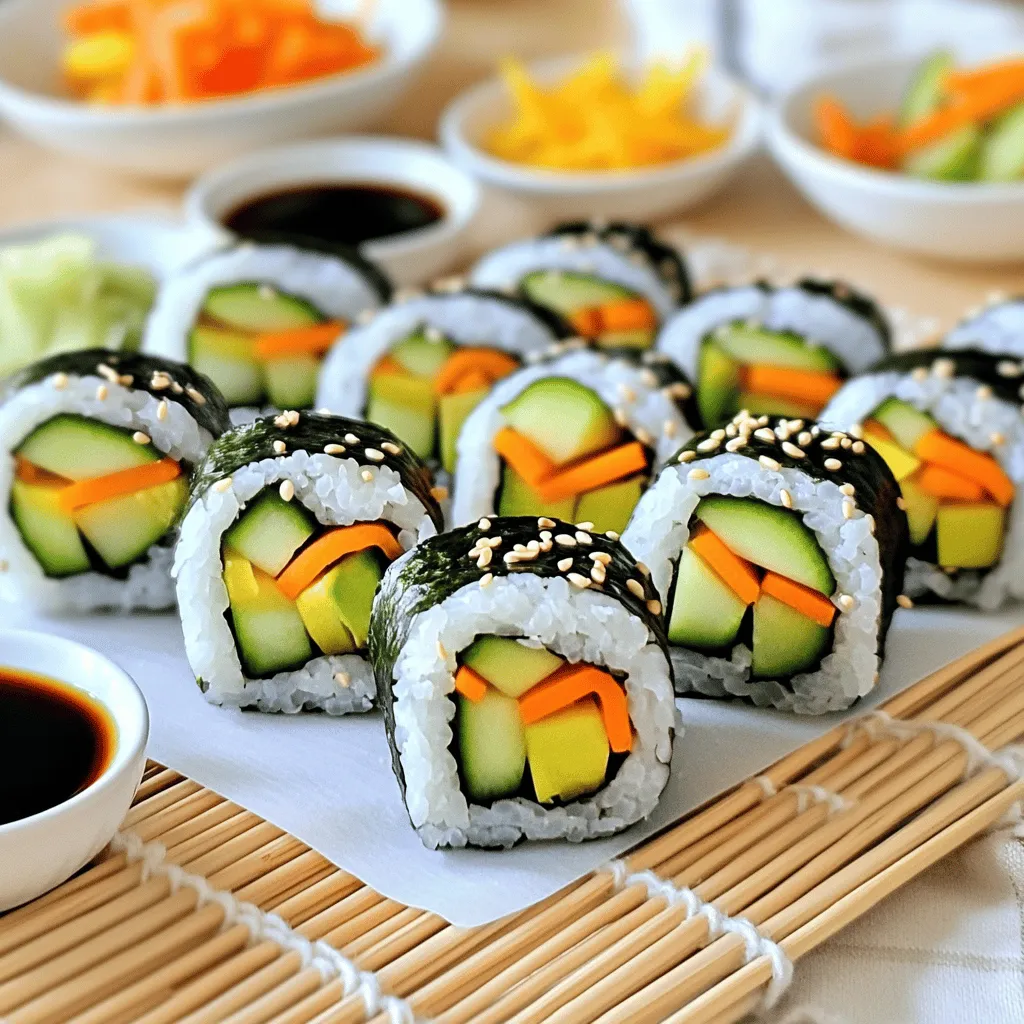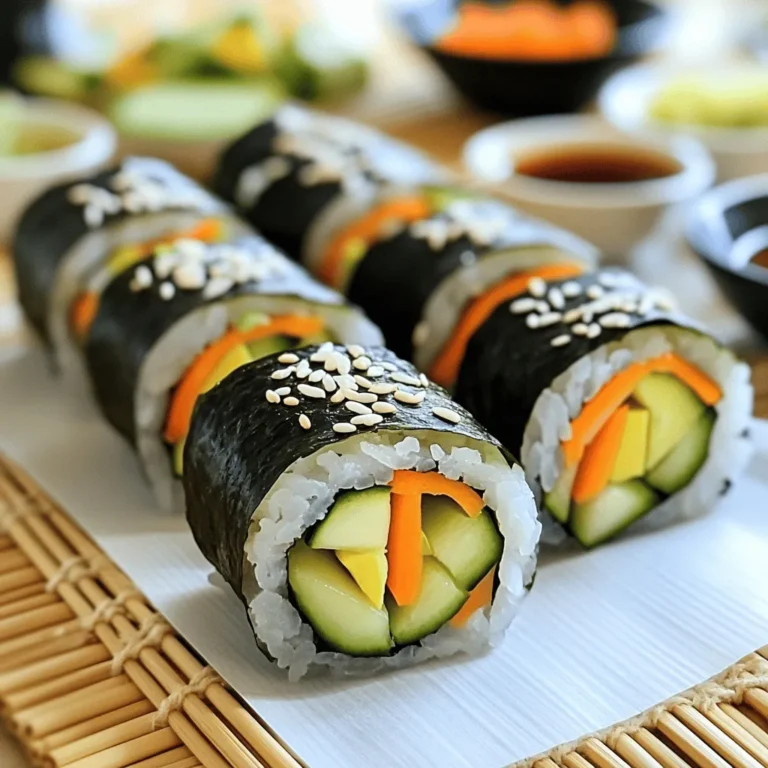Are you ready to roll up something delicious? Making easy veggie sushi rolls is simple and fun! You can enjoy fresh, healthy bites that taste amazing. With just a few ingredients and some basic steps, you’ll create sushi that impresses everyone. Whether you’re a beginner or a pro, my guide will help you master this skill. Let’s dive into the world of veggie sushi and unlock your next favorite meal!
Ingredients
Essential Ingredients for Easy Veggie Sushi Rolls
To make easy veggie sushi rolls, you need a few key ingredients. Here’s what you’ll need:
– 2 cups sushi rice
– 2 1/2 cups water
– 4 tablespoons rice vinegar
– 1 tablespoon sugar
– 1 teaspoon salt
– 4 sheets nori (seaweed)
– 1 ripe avocado, sliced into thin pieces
– 1 medium cucumber, julienned
– 1 medium carrot, julienned
– 1 bell pepper (any color), thinly sliced
These ingredients create a tasty base for your rolls. Sushi rice is sticky, which helps hold everything together. Nori adds a nice flavor and texture.
Optional Garnishes and Dipping Sauces
For extra flavor, consider these optional garnishes and sauces:
– Soy sauce, for dipping
– Pickled ginger, for garnish
– Toasted sesame seeds, for garnish
Using these can enhance your sushi experience. Soy sauce adds a salty kick, while pickled ginger cleanses the palate.
Substituting for Fresh Ingredients
If you don’t have all the fresh ingredients, don’t worry! You can substitute as needed. For example:
– Use zucchini or radish in place of cucumber.
– Try using cooked sweet potato instead of avocado.
– If you can’t find nori, you can use rice paper.
These swaps can keep your sushi fun and fresh! Be creative and use what you have. I always encourage experimenting with flavors.
Step-by-Step Instructions
Preparing the Sushi Rice
To make great sushi, you need good rice. Start by rinsing the sushi rice under cold water. Use a fine-mesh sieve, and rinse until the water runs clear. This helps remove excess starch.
Next, add the rinsed rice and 2 1/2 cups of water to a medium saucepan. Heat it over medium heat until it boils. Once it boils, lower the heat and cover the pan. Let it simmer for about 20 minutes. The rice should be tender and all the water should be absorbed.
While the rice cooks, mix the rice vinegar, sugar, and salt in a small bowl. Stir until both the sugar and salt dissolve. Once the rice is done, remove it from heat and let it sit for 10 minutes. Then, transfer it to a large bowl. Gently fold in the vinegar mixture with a wooden spatula. Allow the rice to cool to room temperature.
Rolling Your Sushi Rolls
Get a bamboo sushi mat and place it on a clean surface. Take one sheet of nori and lay it shiny side down on the mat. Wet your hands to keep the rice from sticking. Grab a handful of cooled sushi rice and spread it evenly over the nori, leaving about 1 inch of space at the top.
Now, add your veggies! Layer the avocado, cucumber, carrot, and bell pepper in a line across the middle. Be creative with your colors! Start rolling the sushi from the edge of the mat closest to you. Roll it away from you while applying gentle pressure. When you reach the exposed edge of the nori, wet it with a bit of water to seal the roll.
Slicing and Serving Tips
Use a sharp knife to slice the sushi into bite-sized pieces. To keep your cuts clean, wipe the knife with a damp cloth between slices. Repeat this rolling process with the remaining nori and filling.
Once all rolls are sliced, you can garnish them with toasted sesame seeds if desired. Serve with soy sauce and pickled ginger for dipping. For a nice presentation, arrange the sushi on a decorative platter.
Tips & Tricks
Best Practices for Rolling Sushi
Rolling sushi may seem tricky, but it’s simple with practice. Here are some tips:
– Wet your hands: This prevents rice from sticking to your fingers.
– Use a bamboo mat: It helps shape the roll evenly.
– Apply gentle pressure: This keeps the filling inside without squishing it.
– Leave space at the top: This helps seal the roll.
Choosing the Right Nori and Rice
Selecting quality ingredients makes a big difference. For nori:
– Look for shiny sheets: They should feel crisp and fresh.
– Check for a dark green color: This indicates good quality.
For rice:
– Use short-grain sushi rice: It sticks well and has the right texture.
– Rinse the rice: This removes excess starch for better results.
Ensuring Freshness of Ingredients
Fresh ingredients enhance the flavor of your sushi. Here’s how to keep them fresh:
– Store veggies in the fridge: Keep them in a sealed bag to retain moisture.
– Buy ripe avocado: It should yield slightly when pressed.
– Use the rice soon after cooking: Let it cool, but use it the same day for best taste.

Variations
Alternative Vegetable Fillings
You can mix and match many veggies for your sushi. Try using:
– Spinach or kale for greens
– Radishes for crunch
– Sweet potatoes for a sweet touch
– Zucchini for a mild flavor
– Asparagus for a spring taste
These options add color and fun to your rolls.
Ideas for Vegan and Gluten-Free Options
Making vegan sushi is easy! All the main ingredients are plant-based. For gluten-free options, choose gluten-free soy sauce. You can also use tamari sauce. This keeps your sushi safe for those with gluten issues. Always check labels to avoid hidden gluten.
Creative Flavor Combinations
You can create unique flavors with simple swaps. Think of adding:
– Creamy hummus instead of rice
– Spicy sriracha for a kick
– Fresh herbs like cilantro for zest
– Mango or pineapple for sweetness
These new flavors can change your sushi experience!
Storage Info
How to Store Leftover Sushi Rolls
To store leftover sushi rolls, wrap them tightly in plastic wrap. This keeps them fresh and prevents drying out. Place the wrapped rolls in an airtight container. Store them in the fridge for up to 24 hours. If you leave them too long, the rice will harden.
Best Practices for Keeping Ingredients Fresh
Keep your veggies crisp by storing them in a cool place. Place sliced avocado in a bowl with a splash of lemon juice to stop browning. Store cucumbers and carrots in a sealed bag or container. This keeps them fresh for your next sushi making session.
Reheating and Enjoying Leftovers
Sushi is best fresh, but you can enjoy leftovers. If you want to eat them warm, use a microwave. Place sushi on a plate, cover it with a damp paper towel, and heat for 10-15 seconds. This helps soften the rice without drying it out. Enjoy with soy sauce or your favorite dipping sauce.
FAQs
How do I prevent sushi rice from sticking?
To keep sushi rice from sticking, rinse it well. Use cold water until it runs clear. This removes excess starch. Once cooked, let the rice cool. Wet your hands before handling the rice. This simple step helps you avoid sticky fingers.
Can I use a bamboo mat for rolling other types of sushi?
Yes, a bamboo mat is great for all sushi types. You can use it for veggie rolls, fish rolls, or even dessert sushi. The mat helps create a tight roll. Just remember to cover it with plastic wrap for easy cleaning.
What can I substitute for nori if I cannot find it?
If you can’t find nori, you have options. You can use large lettuce leaves or rice paper. Both work well for rolling. Lettuce gives a fresh crunch, while rice paper adds a chewy texture. These choices make sushi fun and versatile.
You now have the tools to make easy veggie sushi rolls at home. We explored essential ingredients, from rice to optional sauces, and I shared steps from preparation to serving. Remember the tips for rolling and ingredient freshness to improve your rolls. Try different fillings and variations to keep it fun. Finally, learn how to store and enjoy your creations later. With these insights, you can enjoy delicious sushi anytime. Dive in and get creative with your next roll!


